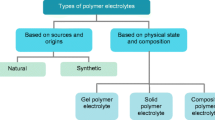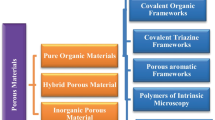Abstract
In the present work, we prepared enormously soluble poly (aniline-co-3-aminophenol) (PA-co-3-AP) copolymers via a simple chemical oxidative method with aniline and 3-aminophenol, and their properties are compared with conventional polyaniline (PA). Concerning the weight percentage (20, 40, 60 and 80%) of 3-aminophenol, the as-prepared polyamines are denoted as PA-co-3-AP20, PA-co-3-AP40, PA-co-3-AP 60 and PA-co-3-AP80, respectively. The structural determination of as-prepared polymers has been explored by X-ray photoelectron spectroscopy (XPS), UV–Vis spectroscopy. The signature property of the conducting polymers is their tunable electrochemical behavior and the copolymers are investigated for their electrochemical activity. In the electrochemical study, the copolymers differ from PA in the single-electron oxidation and reduction, reversibly at various scan rates ranging from 20 to 50 mV. The current density decreases from PA-co-3-AP20 to PA-co-3-AP80 by increasing the loading weight percentage of 3-aminophenol in the polymeric backbone. The present investigation provides further insight into methods to prepare extremely soluble conducting polyanilines for potential electrochemical applications.








Similar content being viewed by others
References
Bhati VS, Nigam ANA, Sharma CS, Kumar M (2019) PAN/(PAN-b-PMMA) derived nanoporous carbon nanofibers loaded on ZnO nanostructures for hydrogen detection. Sens Actuators B Chem 299:126980
Al-Hussaini AS, Eltabie KR, Hassan MER (2016) One-pot modern fabrication and characterization of TiO2@terpoly(aniline, anthranilic acid and o-phenylenediamine) core-shell nanocomposites via polycondensation. Polymer 101:328–337
Khaled MO, Mohamed ERH, Al-Hussaini AS (2019) Novel Fe2O3@PANI-o-PDA core-shell nanocomposites for photocatalytic degradation of aromatic dyes. J Polym Res 199
Al-Hussaini AS, El-Bana WE, El-Ghamaz NA (2020) New semiconducting core-shell nanocomposites. Compos nterfaces 27:385–399
Al-Hussaini AS (2016) New polymeric based materials: terpoly(aniline, diphenyl amine, and o-anthranilic acid)/kaolinite composites. Polym Adv Technol 27:1604–1608
Al-Hussaini AS (2016) Inexpensive fabrication and characterization of crystalline poly(o-anthranilic acid-co-o-phenylenediamine) emeraldine base/bentonite nanocomposites. Polym Plast Technol Eng 55:1386–1392
Al-Hussaini AS, Mohamedein AM, Hassan MER (2021) Towards appraising influence of new economical polymeric core-shell nanocomposite. J Inorg Organomet Polym Mater 31:1491–1502
Al-Hussaini AS, Eltabie KR, Hassan MER (2018) Fabrication of core–shell nanocomposites with enhanced photocatalytic efficacy. Polym Int 67:1419–1428
Apparao T, Arukula R, Narayan R, Rao CRK, Raju KVSN (2015) Energy storage and surface protection properties of dianiline co-polymers. RSC Adv 5:106523–106535
Al-Hussaini AS, Eltabie KR, Hassan MER (2020) Synthesis of smart core-shell nanocomposites with enhanced photocatalytic efficacy. Polym Plast Technol Eng 59:1956–1966
Li T, Wang X, Liu P, Yang B, Diao S, Gao Y (2019) Synthesis of feather fan-like PANI electrodes for supercapacitors. Synth Metals 258:1161
Ravi A, Vinothkannan M, Kim AR, Yoo DJ (2019) Cumulative effect of bimetallic alloy, conductive polymer and graphene toward electrooxidation of methanol: an efficient anode catalyst for direct methanol fuel cells. J Alloys Compd 771:477–488
Belanger D, Ren XM, Davey J, Uribe F, Gottesfeld S (2000) Characterization and long-term performance of polyaniline-based electrochemical capacitors. J Electrochem Soc 147:2923
Li D, Huang JX, Kaner R (2009) B, Polyaniline nanofibers: a unique polymer nanostructure for versatile applications. Acc Chem Res 42:135
Fusalba F, Gouerec P, Villers D, Belanger D (2001) Electrochemical characterization of polyaniline in nonaqueous electrolyte and its evaluation as electrode material for electrochemical supercapacitors. J Electrochem Soc 148:A1
Skotheim TA (1986) Handbook of conducting polymers, vol I and II. Marcel Dekker, New York
Trivedi DC, Nalwa HS (1997) Handbook of organic conductive molecules and polymers, vol 2. Chichester/Wiley, England
Al-Hussaini AS (2021) Eco-friendly synthesis and antimicrobial performance of new heteropolymer composites. J Polym Environ 29:1717–1726
Manohar SK, MacDiarmid AG, Cromack KR, Gindey JM, Enstein AJ (1989) N-substituted derivatives of polyaniline. Synth Met 29:E349-356
Watanabe A, Mori K, Iwabuchi Y, Iwasaki Y, Nakamura Y, Ito O (1989) Electrochemical polymerization of aniline and N-alkylanilines. Macromolecules 22:3521–3525
Chevalier JW, Bergeron J-Y, Dao LH (1992) Synthesis, characterization, and properties of poly (N-alkylanilines). Macromolecules 25:3325
Ito A, Oto K-I, Tanaka K, Yamabe T, Yoshizawa K (1995) n-Alkyl group-substituted poly (m-aniline) s: syntheses and magnetic properties. Macromolecules 28:5618
Chan HSO, Ho PKH, Ng SC, Tan BTG, Tan KLJ (1995) A new water-soluble, self-doping conducting polyaniline from poly (o-aminobenzylphosphonic acid) and its sodium salts: synthesis and characterization. Am Chem Soc 117:8517
Waware US, Arukula R, Hamouda AMS et al (2020) Electrochemical and X-ray photoelectron spectroscopic investigations of conductive polymers. Ionics 26:831–838
Waware US, Rashid M, Hamouda AMS (2019) Poly (aniline-co-3-aminophenol): enhanced crystallinity and solubility. Appl Phys A 125:846
Parthiban A, Le Guen A, Yansheng Y, Hoffmann U, Klapper M, Müllen K (1997) Amino-functionalized poly (arylene ether ketone)s. Macromolecules 30:2238–2243
Wei Y, Harihara R, Patel SA (1990) Chemical and electrochemical copolymerization of aniline with alkyl ring-substituted anilines. Macromolecules 23:758
Pandey SS, Annapoorni S, Malhotra BD (1993) Synthesis and characterization of poly (aniline-co-o-anisidine). A processable conducting copolymer. Macromolecules 26:3190
Nguyen MT, Diaz AF (1995) Water-soluble poly (aniline-co-o-anthranilic acid) copolymers. Macromolecules 28:3411
Yue J, Wang ZH, Cromack KR, Epstein AJ, MacDiarmid AG (1991) Effect of sulfonic acid group on polyaniline backbone. J Am Chem Sot 113:2665
Chen S-A, Hwang G-W (1995) Water-soluble self-acid-doped conducting polyaniline: structure and properties. J Am Chem Sot 117:10055
Cameron RE, Clement SK (1991) US Patent 5008041
Macinnes D, Funt BL (1988) Poly-o-methoxyaniline: a new soluble conducting polymer. Synth Metals 25:235–242
Al-Hussaini AS, Elias AM, Abd El-Ghaffar MA (2017) New poly (aniline-co-o-phenylenediamine)/kaolinite microcomposites for water decontamination. J Polym Environ 25:35–45
Al-Hussaini AS (2018) Novel benzidine and o-phenylenediamine copolymer–matrix microcomposites. J Inorg Organomet Polym Mater 28:871–879
Shacklette LW, Wolf JF, Gould S, Baughman RH (1988) Structure and properties of polyaniline as modeled by single-crystal oligomers. J Chem Phys 88:3955
Cao Y, Li S, Xue Z, Guo D (1986) Spectroscopic and electrical characterization of some aniline oligomers and polyaniline. Synth Met 16:305–315
Masanori K, Akira K, Kazuo S (1986) EPR studies of the charging process of polyaniline electrodes. Chem Lett 15:147–150
Yang Z, Wang X, Yang Y, Liao Y, Wei Y, Xie X (2010) Synthesis of electroactive Tetraaniline−PEO−Tetraaniline triblock copolymer and its self-assembled vesicle with acidity response. Langmuir 26:9386–9392
Manohar SK, MacDiarmid AG (1991) Polyaniline: pernigranile, an isolable intermediate in teh conventional chemical synthesis of emeraldine. Synth Met 41:711–714
Jing X, Wang Y, Wu D, Qiang J (2007) Sonochemical synthesis of polyaniline nanofibers. Ultrason Sonochem 14:75–80
Feng X, Shi Y, Jin S (2015) Three-dimensional microporous polypyrrole/polysulfone composite film electrode for supercapacitance performance. Appl Surf Sci 353:788–792
Tan L, Cao L, Yang M, Wang G, Sun D (2011) Formation of dual-responsive polystyrene/polyaniline microspheres with sea urchin-like and core-shell morphologies. Polymer 52:4770–4776
Al-Hussaini AS, Abdullah MM, Mohamed ERH (2021) Highest degradation of aromatic dyes by new MgO@ PANI-o-PDA core–shell nanocomposites. Polym Bull. https://doi.org/10.1007/s00289-021-03682-1
Albuquerque JE, Mattoso L, Faria R, Masters J, MacDiarmid A (2004) Highest degradation of aromatic dyes by new MgO@ PANI-o-PDA core–shell nanocomposites. Synth Met 146(1):1–10
Harle HD, Ingram JA, Leber PA, Hess KR, Yoder CH (2003) A simple method for determination of solubility in the first-year laboratory. J Chem Edu 80:560
Acknowledgements
We gratefully acknowledge the Qatar University, Doha, for providing the necessary research funding. We also acknowledge the instrumentation facilities provided at CLU and CAM of Qatar University, Doha.
Author information
Authors and Affiliations
Corresponding authors
Ethics declarations
Conflict of interest
The authors declare that they have no conflict of interest.
Additional information
Publisher's Note
Springer Nature remains neutral with regard to jurisdictional claims in published maps and institutional affiliations.
Rights and permissions
About this article
Cite this article
Waware, U.S., Arukula, R., Hamouda, A.M.S. et al. Cyclic voltammetry and XPS studies of poly (aniline-co-3-aminophenol). Polym. Bull. 80, 3897–3910 (2023). https://doi.org/10.1007/s00289-022-04213-2
Received:
Revised:
Accepted:
Published:
Issue Date:
DOI: https://doi.org/10.1007/s00289-022-04213-2




